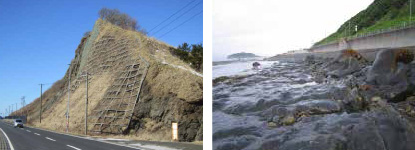
A towering cliff said to resemble a traditional Japanese folding screen is found along a national highway to the east of Samani’s Odori district center. The cliff is made up of layers of sandstone and conglomerate that were deposited at the bottom of the sea during the Neogene Period of the Cenozoic Era (16 million years ago) in contrast to the nature of the surrounding Cretaceous geological strata (100 million years ago). The rock surface contains numerous fossils of shells from mollusks that lived in the cold sea currents of the time. Fossils of 15 shell species, including Stimpson’s hard-shelled clams (Mercenaria chitaniana) and Hidaka hard-shelled mussels (Mytilus (Plicatomytilus) hidakensis), have been found, showing that primarily cold currents flowed in local waters at that time (in contrast to the situation today).
The rock-fall protection enclosure by the national highway below the cliff is strictly off limits. The coast below the national highway also has similar geological features. Low tide reveals the rock surfaces there, providing excellent opportunities for observation.


